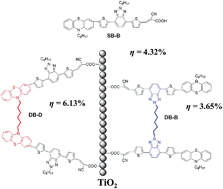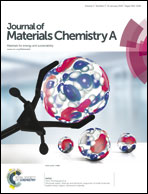Effect of the linkage location in double branched organic dyes on the photovoltaic performance of DSSCs
Abstract
Two novel double branched D–π–A organic dyes (DB dyes) are synthesized to investigate the influence of the linkage location in DB dyes on the performance of dye-sensitized solar cells (DSSCs), where phenothiazine is introduced as a donor, thiophene–benzotriazole unit as the π-bridge and cyanoacrylic acid as the electron-acceptor. The photophysical, electrochemical and photovoltaic properties of the dyes are systematically investigated. The results show that the location of the linkage unit has a small effect on the physical and electrochemical properties of the dyes. However, when the dyes are applied in DSSCs, an obvious decline of short-circuit current (Jsc) and open-circuit voltage (Voc) is found by moving the linkage unit from the donor part to the π-bridge part. The DSSC based on the dye DB-D with the linkage unit in the donor obtains an overall power conversion efficiency of 6.13%, which is about 68% higher than that (3.65%) of the DSSC based on the dye DB-B with the linkage unit in the π-bridge. The DB-B based device exhibits a lower efficiency due to its serious aggregation and short electron lifetime. The results indicate that the linkage location of the dyes has a big effect on the performance of the DSSCs.


 Please wait while we load your content...
Please wait while we load your content...